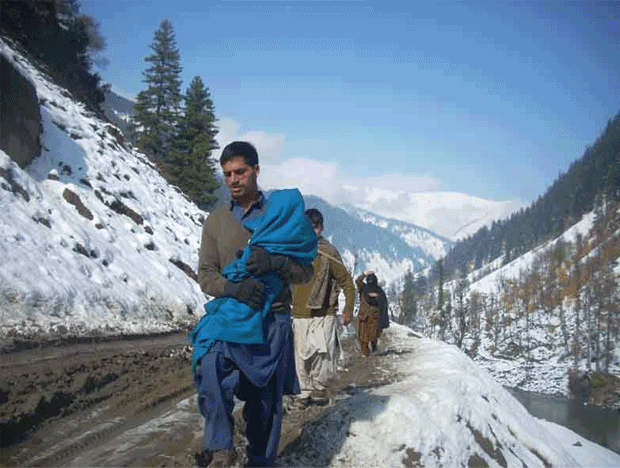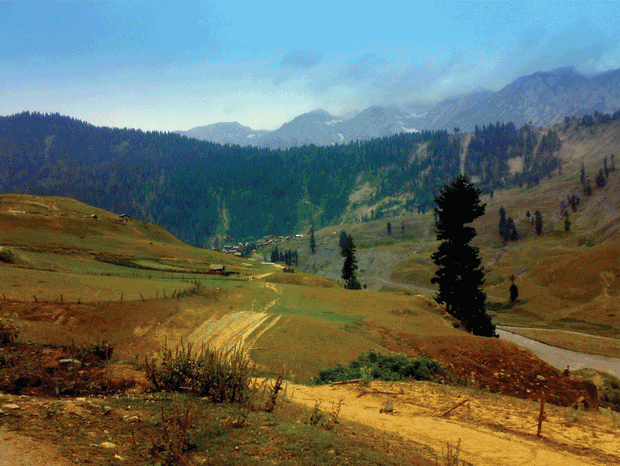|
Gurez or Gurais, also pronounced Gorai in the local
Shina language, is a valley located in the high Himalayas , about 86
kilometres (53 mi) from Bandipore and 123 kilometres (76 mi) from
Srinagar in northern Jammu and Kashmir. At about 8,000 feet (2,400 m)
above sea level, the valley is surrounded by snow capped mountains. It
has diverse fauna and wildlife including the Himalayan brown bear and
the snow leopard. The Neelum River flows through the valley. The road to
Gilgit runs through Gurais.
Gurais is divided into three regions. The area from Baghtor to Sharda
Peeth is administered by Pakistan as Neelum District, that between Kamri
and Minimarg is part of the Astore District, Northern Areas, Pakistan,
and that from Baghtor to Abdullae Tulail is known as Tehsil Gurez, and
is part of Bandipore district.
Being situated very close to the Burzil pass, which leads into Astore
District of the Northern Areas, the inhabitants are ethnic Dards/Shins.
They speak the Shina language and have the same styles of dress and
culture as their kinsmen in Pakistan's Northern areas.
Dawar is the central township in the area. The population of the area is
estimated to be about 30,000, and is scattered among fifteen villages.
Due to heavy snowfall in winter, the valley remains cut off for six
months of the year.
|
|
 |
|
Historically, Gurais was part of ancient Dardistan, stretching between
Sharada Peeth in the west, Minimarg in the north, Drass in the east, and
Baghtor in the south. The valley falls along the ancient Silk Route,
which connected the Kashmir Valley with Gilgit, before continuing
further to Kashgar. Archaeological surveys in valleys north of Gurais
have uncovered hundreds of carved inscriptions in Kharoshthi, Brahmi,
and Tibetan. In particular, the carvings provide insights into the
origins of the Kashmiri people and the early history of Buddhism.
The ancient capital of the Dards, Dawar, is located in the Gurais Valley
and is an important archaeological site. Other archaeological sites of
importance in the valley include Kanzilwan, where the last council of
Buddhism is believed to have been held and, further downstream, the
ruins of the ancient Sharada University are preserved along the
Kishenganga/Neelum River.
Prior to the Partition of Kashmir, Gurais had been a popular destination
for foreign tourists, including Franklin Delano Roosevelt, who is known
to have visited some time before he became the US president. During the
colonial period, Gurais was often visited by trekkers. Nehru and Indira
Gandhi, accompanied by Sheikh Abdullah, were among those who visited the
area in the 1940s, fishing for trout at Naranag, one of the lakes in the
mountains above the valley.
Gurais's most formidable peak is Habba Khatoon, around which legends
abound and at one time, even a film starring Dimple Kapadia was planned.
This pyramid shaped peak was named after the Kashmiri poetess Habba
Khatoon. She was a beautiful and intelligent woman from Saffron village,
and originally known as "Zoon" (which means Moon in English). She was
the daughter of a peasant, who married her to an illiterate peasant boy
named Habba. Zoon was ill-treated by her mother-in-law and husband,
because she spent most of her time in poetry and singing. Dejected by
her plight, she changed her name to Habba Khatoon.
|
|
 |
|
The emperor of Kashmir, Yousuf Shah Chak, was entranced by her beauty,
intelligence and poetry. He arranged her divorce from Habba and married
her. According to the story, Shah Chak was imprisoned by his rival King
Akbar, Habba Khatoon used to wander near the peak that now bears her
name to look for her lover. After her husband's death, she wandered the
banks of river Jhelum in mourning. She died twenty years later, and was
buried in Athawajan.
Habba Khatoon Drama club was founded in 1976 by the poet Hajji Abdul
Aziz Samoon. The club played a pivotal role in safeguarding the cultural
ethos and traditions of the Dard-Shin tribe.
|
|
 |